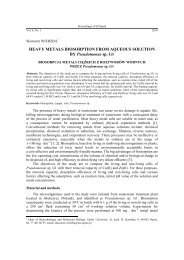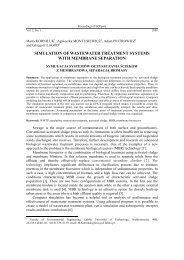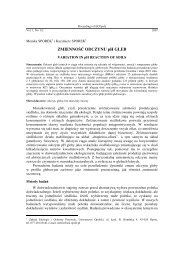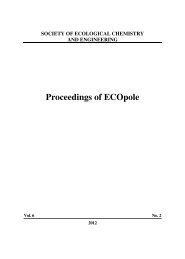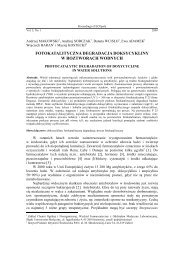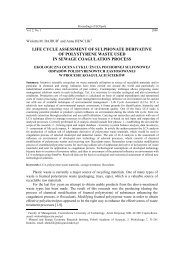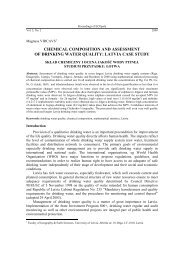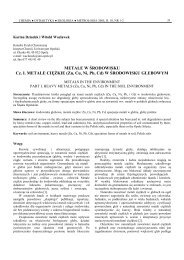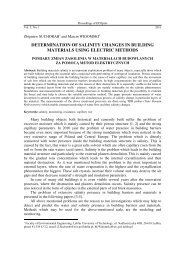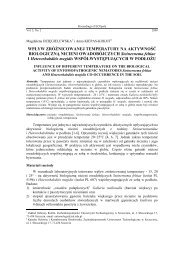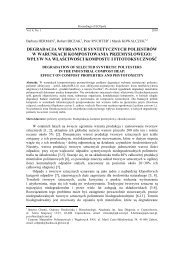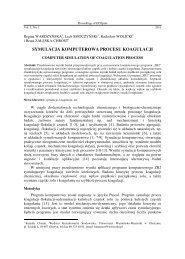Microscopic saprotrophic and phytopathogenic fungi from nature
Microscopic saprotrophic and phytopathogenic fungi from nature
Microscopic saprotrophic and phytopathogenic fungi from nature
Create successful ePaper yourself
Turn your PDF publications into a flip-book with our unique Google optimized e-Paper software.
Proceedings of ECOpole<br />
Vol. 2, No. 2 2008<br />
Ewa B. MOLISZEWSKA 1<br />
MICROSCOPIC SAPROTROPHIC<br />
AND PHYTOPATHOGENIC FUNGI<br />
FROM NATURE RESERVE LIGOTA DOLNA IN OPOLE REGION<br />
MIKROSKOPOWE GRZYBY SAPROTROFICZNE I FITOPATOGENICZNE<br />
Z REZERWATU ŚCISŁEGO LIGOTA DOLNA NA OPOLSZCZYŹNIE<br />
Summary: In the Nature Reserve Ligota Dolna two-year investigations on the occurrence of microscopic <strong>fungi</strong> on<br />
l<strong>and</strong> plants were done. The 46 species of <strong>fungi</strong> were recognized. They were mostly the members of the<br />
anamorphic <strong>fungi</strong> as well as two species of Erysiphales <strong>and</strong> seven species of Uredinales were found. Three species<br />
of hyperparasites were also recognized: Trichoderma piluliferum on Absidia glauca, Ampelomyces quisqualis on<br />
Erysiphe cichoracearum as well as on Microsphaera alphitoides, <strong>and</strong> Cladosporium aecidiicola on the old thelli<br />
of Cronartium flaccidium. Only 11% of total plant species were infected by <strong>fungi</strong>. The investigations were done<br />
before the beginning of usage of the motorway A4, which is localized near by the Nature Reserve Ligota Dolna.<br />
Keywords: microscopic <strong>fungi</strong>, phytopathogens, xerothermic conditions, motor way<br />
There was not done any mycological research in the Nature Reserve Ligota Dolna in<br />
Opole region before. First investigations were undertaken in 2000 <strong>and</strong> continued in 2001<br />
year.<br />
The Nature Reserve Ligota Dolna is one of the smallest of the protected areas situated<br />
in the south-western Pol<strong>and</strong> near Opole, on the Kamienna Góra hill, which is the part of the<br />
Masyw Chełmski (Fig. 1).<br />
Fig. 1. Localization of the Nature Reserve Ligota Dolna [18]<br />
1 Faculty of Natural <strong>and</strong> Technical Sciences, University of Opole, ul. kard. B. Kominka 4, 45-035 Opole,<br />
email: ewamoli@uni.opole.pl
350<br />
Ewa B. Moliszewska<br />
This localization of Nature Reserve Ligota Dolna is crucial for its microclimate.<br />
Particular exposition of the hill decides on the great solarization, high temperatures <strong>and</strong><br />
strong as well as warm winds. Those factors influence on the xerothermic properties of the<br />
ground [1, 2]. The vegetative period starts rather late <strong>and</strong> is about one month later then in<br />
other parts of the Opole region.<br />
The dominant plant communities are xerothermic grassl<strong>and</strong> <strong>and</strong> bushes with group of<br />
thermo-, helio- <strong>and</strong> kalcyphytes existing on the rock. There are 203 species of plants, 38<br />
species of bryophytes <strong>and</strong> 4 species of lichens. The frequently occurring there plants are:<br />
Teucrium botrys, Sedum album, Ligustrum vulgare as well as Allium montanum,<br />
Brachypodium pinnatum, Prunus spinnosa [1, 2].<br />
The aim of this work was revision <strong>and</strong> determining some <strong>saprotrophic</strong> <strong>and</strong><br />
<strong>phytopathogenic</strong> <strong>fungi</strong> in the Nature Reserve Ligota Dolna before start of use of the<br />
motorway A4.<br />
Materials <strong>and</strong> methods<br />
Investigations of the occurrence of the microscopic <strong>fungi</strong> in the Nature Reserve Ligota<br />
Dolna were conducted <strong>from</strong> early summer (June) to the start of the autumn (September)<br />
during 2000 <strong>and</strong> 2001, this is the term of the main vegetation development in this area. The<br />
area of Nature Reserve Ligota Dolna was divided onto three parts dependly on the main<br />
plant community: 1 - rock grassl<strong>and</strong> (Allium montanum-Sedum album), 2 - hill (Adonido-<br />
Brachypodietum pinnati), 3 - xerothermic grassl<strong>and</strong> (Koelerio-Festucetum sulcatae), also<br />
some investigations were made in the outside part of the Nature Reserve Ligota Dolna.<br />
Fungi were recognized directly on the plant material (some of them were put in wet<br />
chambers) also some plant parts were put on the water agar or PDA medium to obtain<br />
fungal colonies. The frequency of <strong>fungi</strong> was based on the scale given by Adamska et al [3]:<br />
0 - rare, + - relatively frequent fungal occurrence, ++ - frequent fungal occurrence <strong>and</strong> +++<br />
- very frequent fungal occurrence.<br />
Plants were determined after Szafer et al [4] <strong>and</strong> their nomenclature follows that of<br />
Mirek et al [5]. Fungi were determined according Majewski [6, 7], Kwaśna et al [8], Nelson<br />
et al [9], Pidopliczko [10], Sutton [11], Domsh et al [12], Ellis [13], Ellis <strong>and</strong> Ellis [14, 15],<br />
Sałata [16] <strong>and</strong> their nomenclature was checked in Index Fungorum database [17].<br />
Results <strong>and</strong> discussion<br />
Plant material collected in the Nature Reserve Ligota Dolna was total of 23 species, all<br />
of them had visible spots of damaged tissues or visible mycelium on the surface. Fungal<br />
material consisted of 46 species belonged to different taxa, but the most numerously<br />
members of anamorphic <strong>fungi</strong> were present. The seven species of the Basidiomycotina were<br />
associated with seven plant species. There were found only two species of Erysiphales:<br />
Erysiphe cichoracearum DC. <strong>and</strong> Microsphaera alphitoides Griffon et Maubl. There were<br />
no members of Mastigomycotina except Absidia glauca Hagem. Fungal hyperparasites<br />
were found four times: Trichoderma piluliferum Webster & Rifai on Absidia glauca<br />
Hagem, Ampelomyces quisqualis Ces. on E. cichoracearum <strong>and</strong> M. alphitoides as well as<br />
Cladosporium aecidiicola Thüm. on Cronartium flaccidium (Alb. & Schwein) G. Winter.<br />
In Pol<strong>and</strong> A. quisqualis was very frequently found on Erysiphales by Czerniawska et al
<strong>Microscopic</strong> <strong>saprotrophic</strong> <strong>and</strong> <strong>phytopathogenic</strong> <strong>fungi</strong> <strong>from</strong> <strong>nature</strong> reserve ligota dolna in Opole region<br />
[19] in the Drawsko L<strong>and</strong>scape Park, but there was no information about C. aecidiicola on<br />
C. flaccidium as a host.<br />
The most of recognized <strong>fungi</strong> were found on rock grassl<strong>and</strong> (Allium montanum-Sedum<br />
album), there were found 28 <strong>fungi</strong> species on 45 plant individuals <strong>and</strong> they were 61% of<br />
total collected <strong>fungi</strong> species. In both other parts of the Nature Reserve Ligota Dolna there<br />
were recognized 13 <strong>fungi</strong> species on 15 plant individuals in hill (Adonido-Brachypodietum<br />
pinnati) as well as in xerothermic grassl<strong>and</strong> (Koelerio-Festucetum sulcataethere).<br />
The fungal community in the Nature Reserve Ligota Dolna was rather poor, mostly<br />
there were representants of anamorphic <strong>fungi</strong>. Probably the special xerothermic conditoins<br />
were not favourable for fungal development, although this thesis is not supported by any<br />
research <strong>and</strong> this one should be proved by a future study.<br />
Infected plant species were only 11% of total. There was not done any<br />
phytopathological research on this area before, <strong>and</strong> because of this reason there is no<br />
possibility to compare current <strong>and</strong> past status of the Nature Reserve Ligota Dolna. This<br />
research was made before the beginning of usage of the motorway A4, <strong>and</strong> it would be<br />
interesting, if there is any influence of the motorway on both plant <strong>and</strong> fungal communities<br />
in the Nature Reserve Ligota Dolna in the future. A plant health condition can be modified<br />
by car pollutions in the future also [20]. Burgieł [20] reports that plants grown in a poor<br />
environment conditions especially influenced by car <strong>and</strong> industrial pollutions are frequently<br />
easier infected by facultative parasites <strong>and</strong> less - by obligatory parasites as powdery<br />
mildiews (Erysiphales) or rusts (Uredinales).<br />
Conclusions<br />
The most favourable conditions for fungal development was observed on the rock<br />
grassl<strong>and</strong> (Allium montanum-Sedum album), in this part of the Nature Reserve Ligota<br />
Dolna there were found 61% of total collected <strong>fungi</strong> species. This works is a first revision<br />
of fungal community in the Nature Reserve Ligota Dolna <strong>and</strong> it was done before the<br />
motorway A4 started to be used. The kind of research should be done in the future to<br />
compare the fungal community as well as a plant susceptibility for fungal infections under<br />
the motorway influence.<br />
Acknowledgments<br />
Author thanks for dr K. Spałek (UO) for his help with plant collection <strong>and</strong> their<br />
determination.<br />
References<br />
[1] Sendek A. <strong>and</strong> Babczyńska-Sendek B.: Charakterystyka geobotaniczna rezerwatu Ligota Dolna na<br />
Opolszczyźnie. Zesz. Przyr. OTPN 1989, 26, 3-24.<br />
[2] Nowak A. (ed.), Badora K., Hebda G., Hebda I., Nowak S., Spałek K. <strong>and</strong> Wyszyński M.: Przyroda<br />
województwa opolskiego. Urząd Woj. w Opolu, Wydz. Ochrony Środowiska 1997.<br />
[3] Adamska I., Madej T., Czerniawska B. <strong>and</strong> Błaszkowski J.: Parasitic <strong>and</strong> <strong>saprotrophic</strong> <strong>fungi</strong> <strong>from</strong> Słowiński<br />
National Park. Acta Mycol., 1999, 34(1), 97-103.<br />
[4] Szafer W., Kulczyński S. <strong>and</strong> Pawłowski B.: Rośliny polskie. PWN, Warszawa 1988.<br />
[5] Mirek Z., Piękoś-Mirkowa H., Zając A. <strong>and</strong> Zając M.: Vascular plants of Pol<strong>and</strong>. A Checklist. Polish Bot.<br />
Stud. Guidebook 15, Kraków 1995.<br />
[6] Majewski T.: Flora polska. Grzyby (Mycota). 9: Uredinales I. PWN, Warszawa-Kraków 1977.<br />
[7] Majewski T.: Flora polska. Grzyby (Mycota).11: Uredinales II. PWN, Warszawa-Kraków 1979.<br />
351
352<br />
Ewa B. Moliszewska<br />
[8] Kwaśna H., Chełkowski J. <strong>and</strong> Zajkowski P.: Flora polska. Grzyby (Mycota) 22: Deuteromycetes,<br />
Hyphomycetales, Tuberculariaceae, Fusarium. Inst. Botaniki PAN, Kraków 1991.<br />
[9] Nelson P.E., Toussoun T.A., Marasas W.F.O.: Fusarium Species. An Illustrated Manual for Identification.<br />
The Pensylvania State University Press, University Park <strong>and</strong> London 1983.<br />
[10] Pidopliczko N.M.: Griby - parazity kulturnych rastienij, t. 3. Naukowaja Dumka, Kijew, UA, 1978.<br />
[11] Sutton B.C.: The Coelomycetes, Fungi Imperfecti with Pycnidia Acervuli <strong>and</strong> Stromata. Commonwealth<br />
Mycological Institute, Kew, Surrey, Engl<strong>and</strong> 1980.<br />
[12] Domsh K.H., Gams H. <strong>and</strong> Anderson T.-H.: Compendium of soil <strong>fungi</strong>. Academic Press, London 1980.<br />
[13] Ellis M.B.: More Dematiaceous Hyphomycetes. C A B International, Kew, Surrey, Engl<strong>and</strong> 1976.<br />
[14] Ellis M.B. <strong>and</strong> Ellis J.P.: <strong>Microscopic</strong> Fungi on L<strong>and</strong> Plants. An Identification H<strong>and</strong>book. Croom Helm,<br />
London & Sydney 1985.<br />
[15] Ellis M.B. <strong>and</strong> Ellis J.P.: Micro<strong>fungi</strong> on l<strong>and</strong> plants. Croom Helm 1987.<br />
[16] Sałata B.: Flora polska. Grzyby (Mycota) 15: Ascomycetes, Erysiphales. PWN, Warszawa 1985.<br />
[17] Index Fungorum http://www.indexfungorum.org, CABI Bioscience, 2004.<br />
[18] Stowarzyszenie na Rzecz Ochrony Przyrody Stobrawskiego Parku Krajobrazowego „BIOS” 2002. Przyroda<br />
Opolszczyzny - prezentacja multimedialna. WFOŚiGW w Opolu, UNDP, Federacja Zielonych Grupa<br />
Opolska, Urząd Gminy Popielów.<br />
[19] Czerniawska B., Madej T., Adamska I., Błaszkowski J. <strong>and</strong> Tadych M.: Erysiphales <strong>and</strong> their hyperparasite,<br />
Ampelomyces quisqualis, of the Drawsko L<strong>and</strong>scape Park, Pol<strong>and</strong>. Acta Mycol., 2000, 35(1), 79-84.<br />
[20] Burgieł J.Z.: Fitopatogeniczne grzyby jako bioindykatory zanieczyszczeń atmosfery. Materiały Konferencji<br />
Naukowo-Technicznej Ekologia Rolnicza. WyŜsza Szkoła Pedagogiczna im. Powstańców Śląskich w Opolu,<br />
Instytut Chemii - Agrobiochemia, 1993, 59-62.<br />
MIKROSKOPOWE GRZYBY SAPROTROFICZNE I FITOPATOGENICZNE<br />
Z REZERWATU ŚCISŁEGO LIGOTA DOLNA NA OPOLSZCZYŹNIE<br />
Streszczenie: Prowadzono 2-letnie badania nad występowaniem grzybów mikroskopowych w rezerwacie Ligota<br />
Dolna na Opolszczyźnie. Zidentyfikowano 46 gatunków reprezentowanych głównie przez grzyby anamorficzne<br />
oraz dwa gatunki Erysiphales i siedem gatunków Uredinales. Notowano takŜe wśród nich nadpasoŜyty:<br />
Trichoderma piluliferum na Absidia glauca, Ampelomyces quisqualis Ces. na E. cichoracearum DC. i na<br />
Microsphaera alphitoides Griffon et Maubl. oraz Cladosporium aecidiicola Thüm. na Cronartium fluccidium<br />
(Alb. & Schwein)G.Winter. Zaledwie 11% gatunków roślin wykazywało objawy poraŜenia przez grzyby. Badania<br />
przeprowadzono przed uruchomieniem autostrady A4, która przebiega w bezpośrednim sąsiedztwie rezerwatu.<br />
Słowa kluczowe: grzyby mikroskopowe, fitopatogeny, warunki kserotermiczne, autostrada



